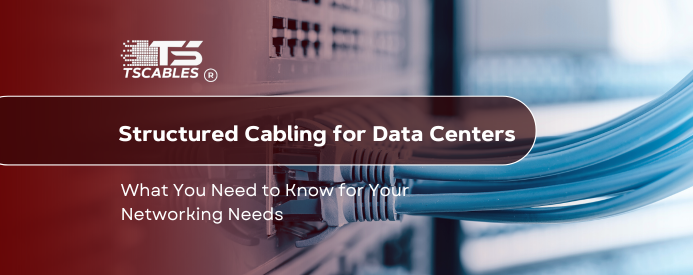Structured cabling is the hidden thread that keeps your data center from turning into a tangled mess. It’s not just about cables; it’s about order, speed, and growth. Understanding how structured cabling works can save time, money, and a whole lot of stress when you're setting up a brand-new space or trying to make sense of your current system.
It lays the groundwork for future upgrades and keeps things running smoothly today. Let’s break it down and look at what structured cabling really means for your network.
What Structured Cabling Really Means?
Structured cabling is a standardized approach to designing and installing a cabling system that supports multiple hardware uses and is suitable for today's needs and those of the future. It involves a series of smaller, standardized elements called subsystems.
These include entrance facilities, equipment rooms, backbone cabling, horizontal cabling, telecommunications rooms, and work area components. The goal is to create a predictable, flexible, and scalable cabling infrastructure that can support a wide range of applications.
What You Need for Structured Cabling Hardware
To set up a structured cabling system, you'll need various hardware components. These include cables (like Cat6 or fiber optics), patch panels, racks, cable managers, and connectors. Each component plays a crucial role in ensuring the system's efficiency and reliability.
For instance, patch panels help organize and manage cables, making it easier to identify and troubleshoot issues. Cable managers keep cables neat and prevent tangling, which can lead to signal interference or damage.
Main Parts of Structured Cabling in Data Centers
A structured cabling system in a data center comprises several key components that work together to provide a reliable and efficient network infrastructure. These components include:
Keeping Everything in Order
Organization is vital in structured cabling. Properly labeled cables, color-coded systems, and neatly arranged racks make it easier to manage and maintain the network. This organization reduces the risk of errors during maintenance and upgrades, ensuring minimal downtime.
Following the Right Rules
Compliance with industry standards is essential. Standards like ANSI/TIA-568 and ISO/IEC 11801 provide guidelines for cabling system design, installation, and testing. Adhering to these standards ensures compatibility, performance, and safety.
Easy to Grow with Your Needs
Scalability is a significant advantage of structured cabling. The modular design allows for easy expansion as your data center grows. Adding new devices or upgrading systems becomes straightforward without overhauling the entire infrastructure.
Simple to Fix and Check
Maintenance and troubleshooting are more manageable with structured cabling. Clear labeling and organized layouts make it easier to identify issues and perform repairs quickly. This efficiency minimizes downtime and keeps the data center running smoothly.
Why Structured Cabling Can Be a Good Idea
Implementing structured cabling in your data center offers several benefits that enhance performance and efficiency. Here are a few of them:
Cutting Down Daily Expenses
Structured cabling reduces operational costs by minimizing power consumption and cooling requirements. Efficient cable management improves airflow, reducing the need for excessive cooling and lowering energy bills.
Keeps Working Even During Problems
A well-designed, structured cabling system enhances network reliability. Redundant pathways and organized layouts reduce the risk of network failures and ensure continuous operation even during maintenance or unexpected issues.
Know What’s Going On and Where
Structured cabling provides better visibility into the network infrastructure. With organized and labeled cables, it's easier to monitor and manage the system, quickly identifying and addressing any problems that arise.
Helps Keep People and Gear Safe
Proper cable management reduces hazards like tripping or electrical fires. By keeping cables organized and secured, you create a safer environment for personnel and protect equipment from damage.
How to Plan Out Structured Cabling
Effective planning is crucial for implementing a structured cabling system that meets your data center's needs. Let’s go over the step-by-step process that can help you out with it.
Know How Much Speed You’ll Need
Assess your current and future bandwidth requirements. Choose cables and hardware that can handle anticipated data loads to ensure the system remains efficient as demands grow.
Think About the Total Cost
Consider both initial installation costs and long-term expenses. Investing in quality materials and professional installation can save money over time by reducing maintenance and upgrade costs.
Choose the Right Type of Cables
Select cables that suit your data center's specific needs. Options include copper cables like Cat6 for shorter distances and fiber optics for longer runs and higher bandwidth. Ensure compatibility with existing equipment and future upgrades.
Keep Heat From Building Up
Proper cable management improves airflow, preventing overheating. Use cable trays and racks to keep cables organized and away from airflow paths, maintaining optimal temperatures for equipment.
Be Ready for What’s Next
Design your cabling system with future growth in mind. Leave room for additional cables and equipment, and choose scalable solutions that can adapt to evolving technologies and increased demand.
Final Thoughts
Structured cabling is essential for a reliable and efficient data center. It simplifies management, enhances performance, and prepares your infrastructure for future growth.
If you need help with your data center's structured cabling, then reach out to TS Cables for expert solutions tailored to your networking needs.
FAQs
Q: What are the benefits of structured cabling in a data center?
A: Structured cabling offers organized infrastructure, scalability, easier maintenance, and improved performance, making it essential for efficient data center operations.
Q: How does structured cabling improve network reliability?
A: By providing organized and standardized cabling, it reduces the risk of errors and downtime, ensuring consistent network performance.
Q: What types of cables are commonly used in data centers?
A: Data centers typically use copper cables like Cat6 and fiber optic cables, depending on distance and bandwidth requirements.
Q: How does structured cabling support future growth?
A: Its modular design allows for easy expansion and upgrades, accommodating new technologies and increased data demands.
Q: Why is proper cable management important in data centers?
A: It prevents overheating, reduces maintenance time, and ensures a safer environment by keeping cables organized and accessible.






